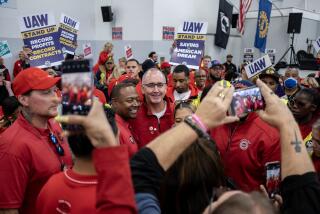GM Winds Up Round-the-Clock Shifts in Ohio : Autos: The Lordstown workers may soon be joined by thousands of others as the worldâs largest auto maker struggles to turn a profit on its North American car production.
LORDSTOWN, Ohio â Wednesday nights at Choiceâs bar have been a lot more lively since the General Motors Corp. assembly plant here became the companyâs first factory in North America to produce cars round-the-clock last month.
By 10 p.m., when the Oldies tunes start to crank up, the dance floor is packed with dozens of workers from the plantâs newly formed third crew--who now take their weekend in the middle of the week as part of the labor arrangement that keeps the plant running 24 hours a day.
The new schedule has wrought havoc with the sleeping and eating habits of Lordstownâs âC-crewâ workers, who work days Friday and Saturday, then switch to the night shift Sunday and Monday. âWhen do you eat breakfast?â one weary-looking welder demands of his colleagues over the din. âTell me what day it is first,â another responds.
But despite the reigning sense of confusion, there is one certainty among those in the boisterous crowd: Tomorrow is their day off.
If the worldâs largest auto maker has its way, the Lordstown workers will soon be joined by thousands of others across the country on their Wednesday nights out, as what has been the regular pattern of auto workersâ lives is altered to fit the changing needs of the troubled auto giant.
Lordstown--the focus of GM labor trouble just a few weeks ago--might seem an unlikely place to emerge as the prototype of flexibility and labor-management cooperation for GMâs future. The UAW local has a long tradition of militancy and, in the early 1970s, became a symbol of the auto industryâs strained labor relations.
âDonât get us wrong,â says Darwin Cooper, 45, who likes to reminisce with his colleagues over drinks at Choiceâs about their radical youth. âWe still donât trust the company. Itâs just that weâve gotten older, and we realized we wanted to keep our jobs.â
GMâs plan to close 21 plants and eliminate 54,000 UAW jobs by mid-decade is designed to rid the company of the costly, under-utilized factory space largely responsible for its staggering $7.1-billion loss in North America last year.
But without the extra room to build cars as demand picks up, the companyâs ability to cling to its traditional dominance of the U.S. vehicle market will increasingly depend on making the most of its remaining production capacity.
As a result, implementing non-traditional work schedules such as Lordstownâs--the product of nearly two years of intense negotiation between GM and the UAW--is crucial to the auto makerâs plan to turn its unprofitable North American car business around.
For the UAW, GMâs reliance on labor--rather than robots and machinery--to increase productivity may mean salvaging some jobs that would otherwise be lost. At Lordstown, the company hired back 1,500 workers from a van plant that it had closed earlier this year to fill in the third crew.
But it will come at the expense of some dramatic changes in workersâ lifestyles. And while the Lordstown work force has few complaints, the international union, scrambling to cope with the specter of the massive GM layoffs, is not eager to ask the rest of its members to disrupt their sleep patterns just yet.
GM is not the only auto maker showing interest in round-the-clock labor arrangements, which can boost production nearly 50% with virtually no capital investment.
Chrysler Corp. recently adopted a three-shift schedule at the St. Louis, Mo., plant that pumps out its ever-popular minivans. And analysts say Ford Motor Co., whose plants have operated at near 100% of their two-shift capacity throughout the recession, may experiment with going round-the-clock at a number of sites over the next few years.
Although continuous production has long been the norm in industries such as oil, steel and chemicals, where heavy factory start-up costs have dictated a 24-hour labor cycle, the auto industry has traditionally shied away from the headache of running its plants nonstop.
In part that is because building cars nonstop is no easy task, even with UAW cooperation. âYou have to make a psychological leap in order to implement three-shift production,â says Clifford Swenson, a consultant at Jacobs Automotive, a Little Falls, N.J.-based firm. âFlexibility has to be built in all the way down the line, from the supplier system to maintenance. Itâs a whole change in the process of the way things are done.â
But in an increasingly competitive world vehicle market, investing up to $1 billion in a new plant has become a dicier proposition than it once was. And with new technology, which makes coordinating clean-up and maintenance less arduous, auto makers are showing more interest in increasing the flexibility of their existing facilities.
Ordered to make a more-than-psychological leap back to profitability by its board of directors, GM management has sought to underscore its message to the UAW that more Lordstowns are in order. In February, the company said it will close a plant in Ypsilanti, Mich., instead of one in Arlington, Tex., largely because the Arlington workers said they were willing to adopt a work schedule similar to Lordstownâs.
And the boardâs installation of John F. Smith Jr. as company president last April appeared to ensure the spread of continuous production within the companyâs U.S. plants. The Lordstown plantâs system is modeled on that of a GM plant in Antwerp, Belgium, one of three European plants where Smith set up round-the-clock production as part of the strategy that salvaged the companyâs stumbling European operations under his leadership in the late 1980s.
But if Lordstown is to be a model for a more flexible and efficient GM on this side of the Atlantic, it is off to a decidedly inauspicious start.
Three weeks after the new production schedule kicked in, the assembly line ground to a halt when the parts-making plant next door went on strike. Then the assembly plant workers threatened a separate strike of their own. And even now, with one strike settled and the other averted, there is some resistance among the workers to the unsettling new schedule.
âI havenât slept since this started,â says Helen Urbania, who works the C-crew schedule in the plantâs paint shop. âItâs like having jet lag all the time.â
Even so, most of the Lordstown workers like the new arrangement, which gives them less overtime pay but more time off. And even those who dislike it say they are happy to be working at a time when many of their fellow GM workers are losing their jobs.
The company, pleased with Lordstownâs success, was until recently anxious to show off its only American assembly plant now operating round-the-clock. But that has changed since the dual labor disputes here in late August.
Last week GM denied a reporterâs request to tour the plant and speak with the plant manager.
Before drawing the publicâs attention to Lordstownâs alternate work schedule, âwe want to distance ourselves from the recent labor issues,â company spokeswoman Linda Cook says.
Analysts and the UAW, however, say the two are not so unrelated as the company would like to make out. The main issue in the parts plant strike, which idled 42,000 workers over 10 days, was GMâs plan to âoutsourceâ work from the plantâs tool and die shop to a non-union supplier.
Similarly, the assembly plant workers threatened to strike unless the company transferred Sunbird and Cavalier production from its plant in Ramos Arizpe, Mexico, back to Lordstown.
Slashing the cost of building cars and purchasing parts--often most easily achieved by avoiding the $17-an-hour UAW wages--rivals production flexibility in its significance to GMâs restructuring plan.
But the auto maker needs the unionâs cooperation on both scores. âIf GM alienates the union over outsourcing, it could create an even bigger headache for the corporation over work rules. Thatâs the thin line GM was walkingâ during the recent strike, says labor expert Harley Shaiken at UC Berkeley.
Although GM, eager to preserve labor peace, agreed to both delay the closing of the tool and die shop and transfer the Mexican car production to Lordstown, achieving the UAWâs cooperation on work rules may not prove an easy task.
All such agreements must be approved by both the local and the unionâs international leadership. Steven Yokich, the unionâs top GM negotiator, has already vowed to block any other round-the-clock agreements--at least until the national contract negotiations in September, 1993.
The union fears that squeezing more workers under fewer roofs will mean a net loss of jobs and overtime pay. And UAW officials are also anxious to prevent local unions from caving in to GM âwhipsawingâ by granting work rule concessions to save their jobs, as the Arlington work force was widely believed to have done.
There is also a sense of the labor movement losing ground. For some Lordstown workers, brought up in Ohioâs steel-mill towns listening to their fathers and uncles complain about the switch from night shifts to day shifts typical in the steel industry, the C-crewâs swing-shift schedule was a particularly bitter pill to swallow.
But most industry observers believe that the union has accepted the changes at the worldâs largest auto maker--and in their own lives--as inevitable.
Bill Bowers, president of UAW Local 1112, which represents the Lordstown assembly workers, has received requests from other locals across the country for copies of Lordstownâs labor agreement.
âEvery local union in the circuit is interested in what we did,â Bowers says. Adds veteran auto worker Robert Connolly: âWe are the future.â
For GM, that future means squeezing 500,000 cars a year out of a plant that previously could pump out only 420,000, even with lots of overtime. For the Lordstown work force, it means three-day weekends and new jobs for the complexâs van plant workers. But it also means less overtime and thus less cash.
Jim DiMaido, 44, who has been having trouble making his child support payments with the thinner paycheck, puts it bluntly: âThe time is nice, but Iâd rather have the money.â Mike Aurillo, a welder who now works the Monday-to-Thursday day shift, has another problem: how to avoid spending too much money on his extra day off. The 23-year GM veteran says the additional free time, which he is devoting to remodeling his house, is âa real plus.â
And he has made a shocking discovery as a result of his new work schedule: âI found out there are actually people outside during the day. Thereâs traffic and everything.â
The 2,000 workers assigned to C-crew get an extra $100 or so a week for their Saturday and Sunday duty, but they have other problems, such as figuring out which way is up.
âHave you ever tried to eat at night what you eat in the morning?â asks Ruddy John, 48, whoâs been compromising with a lot of peanut butter and jelly sandwiches at his erratic meal times.
Robert Connolly says the C-crewâs problems would be solved if they would just follow his example and eat one meal a day at 5 p.m., the only hour they have free every day of the week. But confusion persists.
Some miss Saturdays with their families, and Sunday dinners have to be eaten early, since they have to be at work by seven. But others, used to working the night shift that more often than not included Saturday night overtime, are exulting in the first bit of evening socializing theyâve done in years.
And no matter what their reservations regarding the time and money trade-offs of the new schedule, Lordstown workers are nearly unanimous in contending that ratifying the three-crew schedule was worth it to keep their fellow union members employed.
âWe were fortunate,â Bowers says. âGM needed the production and we needed the jobs, and we were able to work it out so both sides won.â
There are still points of tension between labor and management at Lordstown, although not all of them are enough to provoke strike threats. Before it switched to the new system, for example, GM distributed elaborate, color-coded plastic cards with the suggested times for each crew to eat, sleep and socialize on their new schedule. The company, apparently, had it all worked out.
But the large placards that have been appearing on cars coming down the assembly line suggest otherwise. They read: âHey General Motors, you forgot to tell us when to have sex!â






